
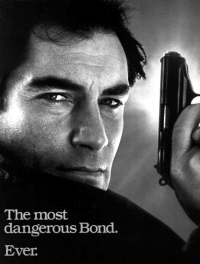 |
The Living DaylightsProducer: EON Released: 1987 |
Best line:
Bond: "Better make that two." (Over the phone after telling the office he'd report in an hour, as a beautiful woman invitingly offers him a drink and some sexual fun.)
Worst line:
Bond: "Better make that two." (Standing over the corpse of Agent Saunders, which has been cut in two, after somebody calls for a stretcher. The line was mercifully cut.)
And...
Bond (when pursuers fall into a vat of red paint): "Better red than dead." (It was also mercifully cut)
Undercover
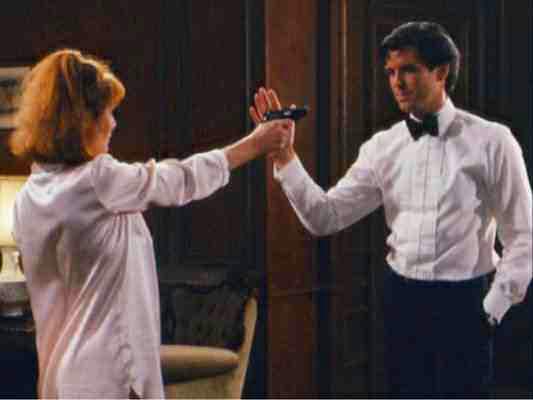 |
Bond co-producer Michael G. Wilson, director John Glen, Dana and Barbara Broccoli "were impressed with Sam Neill and very much wanted to use him." However, Bond producer Albert R. Broccoli was not sold on the actor.[Broccoli, Albert R; Zec, Donald (1998). When the Snow Melts:The Autobiography of Cubby Broccoli. London: Boxtree.] The producers eventually offered the role to Pierce Brosnan after a three-day screen-test. [John Glen. Inside The Living Daylights (DVD)] At the time, he was contracted to the television show Remington Steele which had been cancelled by the NBC network due to falling ratings. The announcement that he would be chosen to play James Bond caused a surge in interest in the series, which led to NBC exercising (on the very last day) a 60-day option in Brosnan's contract to make a further season of the show. NBC's action caused drastic repercussions, as a result of which Albert R. Broccoli withdrew the offer given to Brosnan, citing that he did not want the character associated with a contemporary TV series. Not surprisingly, this led to a drop in interest in Remington Steele, and only 5 new episodes were filmed before the show was finally cancelled. The edict from Broccoli was that "Remington Steele will not be James Bond."[Inside The Living Daylights (DVD)]
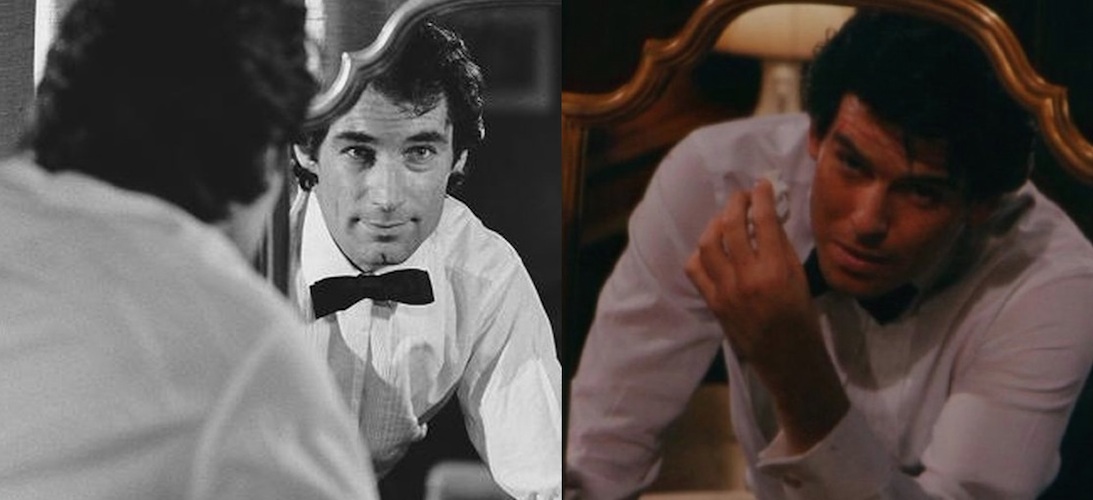
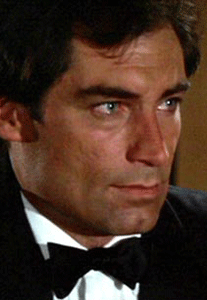 |
Prince Charles and Princess Di visited the set, where she hit her future ex-husband over the head with a bottle (it was a movie prop, of course).
Timothy Dalton promised to take the 007 character back to its literary roots and make him human again. However when he came aboard as Bond, a script for a Moore-like Bond had already been prepared in anticipation of the cheekier Pierce Brosnan. Last minute alterations were made to humanize the character and the sexual double-entendres and bon-mots were cut down.
Timothy Dalton: "The Living Daylights was already written when I came on board, and so it was written as a continuation of the style of the last ten or twelve years or so--a fairly lighthearted, comedic, spoofy, perhaps uninvolving film. But it was a good romantic thriller even though it was of a previous genre."
More (not Moore) Dalton: "It would be idiotic to say that this is necessarily going to be like Fleming. But it is the foundation for all these films, you know. Therefore, for me, anyway, it has to be the foundation of what I do."
Koskov and Whitaker repeatedly use vehicles and drug packets marked with the Red Cross. This action angered a number of Red Cross Societies, which sent letters of protest regarding the film. In addition, the British Red Cross attempted to prosecute the filmmakers and distributors. However, no legal action was taken.[Protection of the red cross and red crescent emblems and the repression of misuse". Icrc.org. 31 October 1989] As a result, a disclaimer was added at the start of the film and some DVD releases.
Bond was monogamous in this movie. Except for the pretitle sequence, in which it is intimated that he's about to sleep with a bikini-clad woman on a yacht, 007 is devoted to Kara (played by Maryam D'Abo), and he doesn't even try anything with her for an hour and a half...
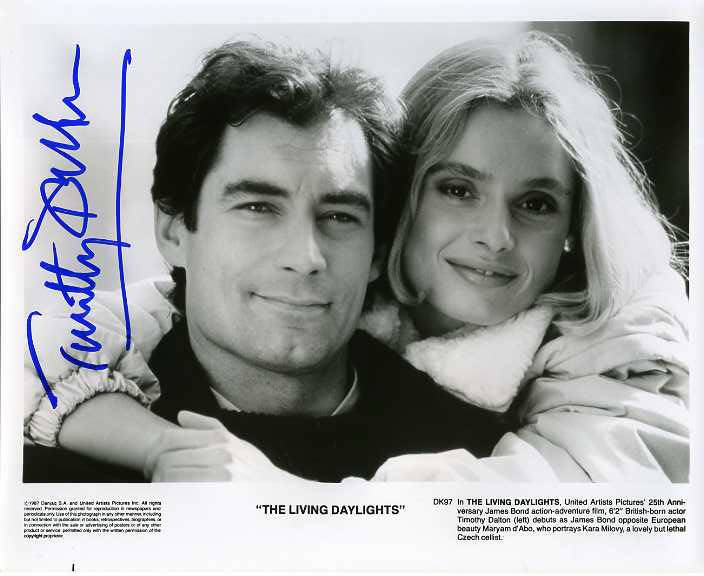
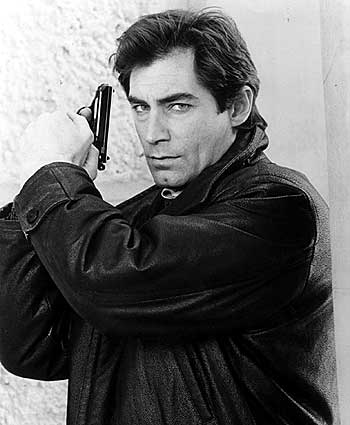 |
"Good news, ladies. The newest James Bond does not hold a woman as though she were a sack of gelignite. His gaze is heat-seeking, despite a tepid script with lines that wheeze like a General Hospital respirator. The bad news? Though the promo squawk touts the latest 007 as 'the most dangerous Bond. Ever,' the sex is too safe. They've gone and cast a guy who could pop hairpins at fifty feet, but in the clinch the plot intrudes like a crabby old duenna."
-- Gerri Hershey, Rolling Stone
Michael Wilson: "Does Bond engage in safe sex? The answer is: How can you tell? I mean, usually the camera slides off somewhere before we see anything."
Screenwriter Richard Maibaum: "You can't have him alley-catting around anymore in the era of AIDS. The disease has been a shock to our sexual psyche, so indiscriminant sex is out. It's just the sensible and responsible thing to do."
Director John Glen: "The sexual revolution is truly over."
In response, the British Press dubbed the new Bond "No No Seven."
EON kind of chickened out with this attempt at being more serious and believable. Instead of crafting a taut, dramatic script for an intense actor like Dalton, they just took a script written for a Moore-like 007 and removed the punchlines, basically stranding a serious Bond in a comical adventure in which a cello case is used as an escape sled from the KGB. Much of this film seems to be written for an aging 007, like an almost-60-year-old Moore (or that's just how they're used to writing Bond at this point), with fewer stunts for the main character, and all the action happening around him. The best fight in the film occurs at a safe house after Bond has just left the building. Wouldn't it have been better to have Dalton's Bond fight the assassin instead of an arbitrary agent carrying a food tray? Then Bond could gets double-crossed by the perceived victim, Koskov, when he's about to win the fight? Koskov is gone and Bond would be humiliated, dressed down by M, and would want to clear his good name on top of uncovering the crime plot. So instead of just a sort of spy procedural with no personal stakes, it would give the film a revenge plot to motivate the characters.
A scene with Bond interrogating the head of the KGB, who 007 has been ordered to assasinate by M, over glasses of champagne was changed after Dalton and Jonathan Rhys-Davies improvised a more intense scene where Pushkin, gun to his head, pleads for Bond to spare his life.
Still, this is easily the best Bond film of the decade. The Living Daylights has a "Fresh" score of 75% on Rotten Tomatoes. IGN lauded the film for bringing back realism and espionage to the franchise and showing James Bond's dark side. The Washington Post even said Dalton developed "the best Bond ever."['The Living Daylights' (PG). Washington Post. 31 July 1987.] Roger Ebert of the Chicago Sun-Times criticised the lack of humour in the protagonist, however,[33] while Jay Scott of The Globe and Mail wrote of Dalton's Bond that "you get the feeling that on his off nights, he might curl up with the Reader's Digest and catch an episode of Moonlighting". [Scott, Jay (3 August 1987). "The Living Daylights: Dalton serves up lethargic James Bond. A licence to bore?". The Globe and Mail: p. C.7]
It would be another 20 years before the producers would get it right, with Casino Royale. The star of that film, Daniel Craig, would list Dalton's portrayal of Bond as an important influence.
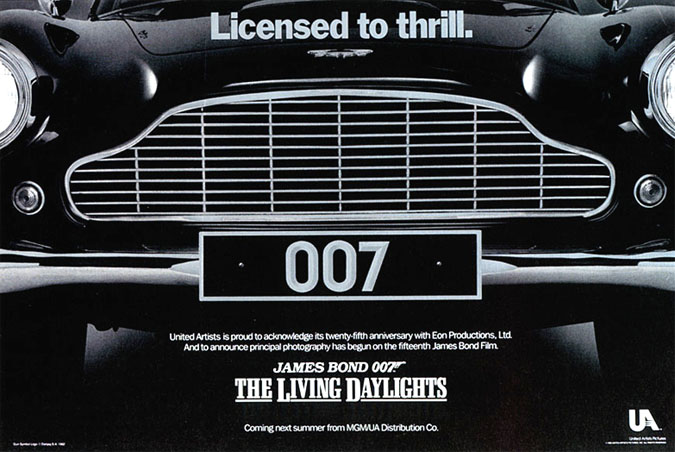
Good Cut
Fortunately they didn't just cut sex - they cut a lot of REALLY BAD jokes. how about this...
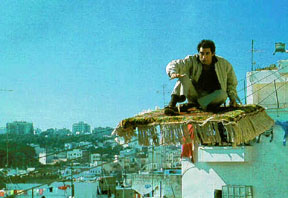 |
an elderly Arab, near doorway on to roof, beating CARPETS hung on lines, with carpet-beater. BOND approaches him.
436 ROOF DOORWAY - POLICEMEN
reaching roof. He sees BOND, draws gun.
437 ABDUL
hitting POLICEMAN with carpet-beater, knocking him back into doorway.
BOND (as he reaches him): Thanks, Abdul. Where is it?
ABDUL points to carpet in corner of roof.
438 BOND
picking up CARPET which is mounted on metal frame. He goes to corner of roof where a pair of telephone lines are affixed. They cross road to roof of building opposite. BOND places frame on lines, and rides over and across road on the telephone lines.
438A ROAD - POLICEMEN
looking up, astonished, to see BOND riding a 'magic carpet'. POLICEMAN speaks excitedly into walkie-talkie. Street sign post above Policeman's head reads "Calle du Zoo."
438B ROOF TELEPHONE LINES - BOND
arriving on roof opposite to one he left. He climbs on to roof taking carpet with him. He crosses to opposite corner where another set of telephone lines are attached. He looks down in surprise.
438C WHAT HE SEES
Lines are lying on the ground. Across the street on a roof a TELEPHONE ENGINEER repairs them.
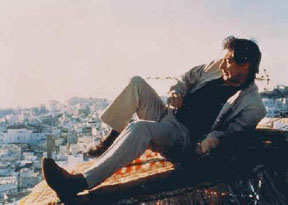 |
throwing down his "magic carpet" disgustedly. He looks about for escape route, sees heavy metal grating set in roof.
438E ROOF WITH WASHING - POLICEMEN
searching for BOND. One sees him on roof across street.
438F BOND
sliding back bolt securing grating. BULLET HITS near him. He ducks down through grating, it is dark below.
438G ROOF WITH WASHING - POLICEMEN
firing at BOND.
438H WALL OF ROOF ABOVE GRATING - CHIEF OF SECURITY
seeing BOND disappear through grating.
438I INT. CORRIDOR - BOND
crouching as he walks through dark narrow corridor. He comes to another grating set in floor. He removes bolts and opens grating. It is dark below. On his knees he sticks his head down through grating to look. Suddenly he is pulled in by something.
438J STAINLESS STEEL SLIDE - BOND
sliding down head first, landing in pile of hay. He looks around.
438K WHAT HE SEES
CROWD of NATIVES, TOURISTS and CHILDREN on other side of bars. They laugh and point at BOND.
438L BOND
turning toward slide at SOUND of tremendous pounding on sides of slide.
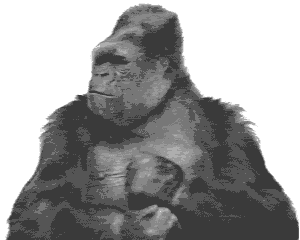 |
a 420 pound gray-backed male GORILLA hurtles down toward BOND.
438N GORILLA
landing in front of BOND. GORILLA grabs him, pulls him close, then reaches out with a huge hand and plucks BOND'S eyelash.
430O ANOTHER ANGLE
behind GORILLA, CHIEF OF SECURITY coming down slide feet first out of control. He crashes into DJUM'S back. GORILLA drops BOND, turns on CHIEF OF SECURITY.
430P BOND
scrambling to door of cage as KEEPER opens it. BABY GORILLA jumps into Bond's arms. BOND hands it to KEEPER.
BOND: Burp him.
He exits cage. In B.G. DJUM wrestles with CHIEF OF SECURITY.
| Films, main | The Eighties |

Return to COMEDY ON TAP
